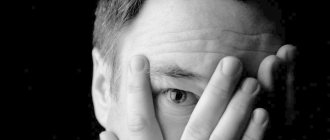We treat phobias based on modern treatment and rehabilitation techniques. The author's technologies of psychotherapy and combined methods using the latest generation neurometabolic therapy are used.
As they say, everyone has their own skeleton in their closet. There are countless varieties of phobias. Everyone has their own fears and phobias. Some people cope with this and do not show their phobia in public. Others, even if they have them, never admit it, skillfully hiding them. For such people, their phobias do not interfere with their lives and do not reduce, or do not greatly reduce, their quality of life. For other people, phobias are so strong that it becomes difficult to hide them, and their quality of life begins to suffer. Their phobias are so developed that they can lock themselves at home and not go outside for years. If the first category can be advised to overcome their phobias by force of will, which often helps, then the second, and especially the third category should be advised only one thing - contact a good specialist in person and begin treatment for the phobia. And here it is no longer so important what a person is afraid of and what exactly his phobia is called. In these cases, treatment of a phobia is always associated with the restoration of biological processes in the brain.
Why treat a phobia?
Phobias are very painful for people to bear, so a person strives to get rid of phobic reactions. To treat a phobia, unfortunately, many turn to psychologists, not knowing that the psychologist does not have the right to treatment, since he does not have a higher medical education. You need to see a psychotherapist.
Brain Clinic specialists have extensive experience in treating phobias of various manifestations and origins. We safely restore the functioning of the nervous system without any side or negative effects on the body.
Do you have a phobia!? Call! We will definitely help you!
Didn't your previous treatment for your phobia help or was the effect weak? Do not despair!
We help in the most difficult cases!
| Initial consultation and examination 2,500 | Treatment and rehabilitation therapy from 5000 |
Causes
According to statistics, pathological fear occurs due to two most common reasons:
- Stressful or traumatic situation. This reason is the most common, although people do not always remember what exactly happened, as a result of which constant fear appeared. However, a series of associations associated with a past situation can cause fear. For example, the fear of driving is based on a previously experienced accident, and the fear of choking is based on food getting stuck, which caused a panic experience. People with a developed imagination can acquire a phobia after a terrible incident with friends, or simply after seeing something frightening on TV.
- Hereditary factor. Many fears, for example, fear of heights, snakes, spiders, etc. are based on the instinct of self-preservation and are inherent in all humanity. However, in people with a weak nervous system or a hereditary predisposition, the instinct of self-preservation can transform into obsessive fear.
Understanding and establishing the true causes of fears is already half the success towards answering the question of how to cope with phobias.
Types of phobias
The most common are social phobia - fear of communication, public speaking, and agoraphobia - fear of open spaces. They are closely followed by claustrophobia - the fear of closed spaces. Less common are fears of blood, spiders, snakes, mice, water, fire, heights, corpses, funeral supplies, darkness, and various diseases. There are also very rare phobias - fear of mirrors, walking across a bridge, or being in certain rooms and on certain types of terrain or with certain types of people.
In principle, almost anything can become a phobia, but one should not go to extremes and confuse a phobia with ordinary fear. For example, every normal person is afraid of heights, but this does not mean that he has a phobia. In the same way, people have a genetic aversion to insects and arthropods. This has a completely reasonable reason - for tens of thousands of years they have been stinging, biting and infecting our ancestors, so a normal person would not rejoice at the sight of a lice or a pot-bellied spider. But we can reasonably talk about a phobia only when the sight of an ordinary house spider or mouse causes a panic attack.
The danger of the condition and the possibilities of modern therapy
Now let's talk about whether treatment for phobias is required, how necessary professional intervention is and how to get rid of phobias and fears on your own. Considering that panic states, even those that do not occur too often, negatively affect the quality of life, it is necessary to ask the question of how to cure a phobia, especially since today there are many techniques that allow you to cope with this condition. The effectiveness of therapy is high both in the case of professional intervention and in self-treatment, subject to the basic rule - there must be a willingness to analyze the underlying factors that provoked the development of fear and a sincere desire to eliminate it from one’s own life. When approaching the problem, specialists use a specific scheme on how to get rid of phobia, fear and panic states:
- The first stage is a clear definition of the phenomenon that causes fear and worsens physical condition.
- The second stage is working with the very cause of fear, while professionals at this stage use hypnosis and psychotherapy techniques. Conducting special sessions helps the patient to realize and accept his fears, and allows him not to lose constructive thinking in the event of a critical situation.
- The third stage of how to treat phobias is controlling fears in practice and the ability to make the right decisions without the desire to escape from reality.
Psychoanalysis as a basis for treatment
The first place to start treatment is psychoanalysis. Its main goal is to displace negative obsessive thoughts.
The first stage is to determine the cause of the phobia. We need to figure out how and why it arose. Typical primary sources are an innate fear of something, childhood trauma, stress from being in a new environment, rejection by loved ones, etc. It happens that the development of the disease is influenced by damage to the central nervous system.
A great way is to write down on a piece of paper all the identified aspects associated with the phobia. Next, it is important to accept your phobias and work hard on yourself. Forcing yourself to act is the key to success. Ask yourself questions:
- what will happen if I do not eliminate fear;
- what will happen if I start treatment;
- why I need to get rid of a phobia;
- Will it become easier for me to live without fear of anything?
The patient determines the prospects. He knows what to expect after treating a phobia. You can additionally write out and place motivational quotes in a prominent place. When a person knows what he is striving for, the incentive is higher.
Psychologists say that you can get rid of a phobia yourself if you encounter it. The first time will be difficult mentally and physically. But subsequently the reaction to the stimulus will be less pronounced. The person will stop feeling stress and anxiety. Panic attacks will be eliminated. It is important to overcome yourself and dare to take such a step.
Another necessary aspect is to change negative thinking to positive thinking. It is necessary to exclude from your vocabulary the words and phrases “always”, “never”, “can’t”, “I won’t”, “but”, “I’ll try”, “should”, etc. Through these statements, negativity accumulates inside. Reconsider your attitude towards the object of fear. Change your negative attitude to a positive outcome. It is important to believe in yourself, and then everything will work out!
The third requirement is to do everything regularly. Once will not be enough. To get the desired result, you need to work on yourself every day. The technique is reminiscent of a gym session. If you attend all workouts regularly, then, after a while, a person has a beautiful figure and a healthy body. If you do it a different number of times, the result will be the same.
When is phobia treatment needed?
Phobias can manifest themselves in the form of various fears, for example:
- loss of consciousness;
- of death;
- committing aggression towards someone or oneself;
- various diseases;
- public, large crowds of people;
- loss of self-control;
- public transport;
- and much more.
The main sign of the presence of the disease is a decrease in quality of life. In this case, the manifestation of the phobia is clearly manifested. When negative thoughts cannot be suppressed by willpower and/or they constantly haunt a person in the form of obsession. It is necessary to treat a phobia in any of its manifestations from the moment the quality of life begins to decline.
There is no need to treat ordinary fears that every person has, since they can be suppressed by an effort of will, they can be overcome, and they do not reduce a person’s quality of life. Such fears do not qualify as phobias.
Help from a psychiatrist
A psychiatrist can conduct a private practice and see patients for a fee. A psychiatrist can prescribe special medications on an outpatient basis that help relieve anxiety and dampen feelings of fear, as well as correct the condition in the longer term.
In addition to doctors in private practice, a good option may be to go to a clinic where psychiatrists also work, and in addition to the outpatient clinic, inpatient treatment is also possible for a more effective selection of medications. The best option for treating a phobia may be:
- neurosis clinic;
- clinic for the treatment of depression and phobias;
- borderline clinic.
Also in such institutions, psychotherapy, group or individual, art therapy and other forms of non-drug treatment are usually possible.
Psychotherapeutic methods for treating phobias and fears
Psychotherapy methods are aimed at identifying the causes of a phobic disorder, eliminating them, rehabilitation, reducing anxiety, correcting inappropriate behavioral reactions, and mastering relaxation techniques. The following methods have been successfully used to treat phobias and fears:
- Psychotherapeutic assistance.
- Rational method of psychotherapy.
- Treatment of phobias using NLP (neurolinguistic programming).
- Cognitive-behaviouristic method.
- Treatment of phobias with hypnosis (including the Erickson method).
- Additional methods.
Proper treatment of phobias
Here are 4 signs that will help you get rid of fear:
- Some relief, an inner feeling of hope, appears after the 1st meeting . Subconsciously, your body seems to feel that these methods and this psychotherapist will help.
- You understand everything that the psychotherapist does . There is nothing mystical or supernatural in phobia therapy. The solution to the problem of fear lies in you, in the ability of your brain and psyche to recover. The therapist's job is to use his knowledge and experience to activate these abilities!
- The strength of fear begins to decrease literally after the first sessions . And gradually, even if in microscopic steps, the phobia continues to recede.
- The psychotherapist uses short-term psychotherapy methods. In order to get rid of fear, you need an average of 12-14 meetings. True, in the case of chronic phobias, as well as social phobia, the time for therapy may increase. But simple phobias - fear of spiders, dogs, mice, elevators, as well as aerophobia - are treated even faster, usually in 6-9 meetings.
Treatment of phobias with medications
The use of medications for phobic disorders is not the main method. This is rather an auxiliary measure. Medications are used mainly to relieve symptoms in the treatment of fears, phobias and panic attacks. Various groups of psychotropic drugs, antidepressants and a number of other drugs are aimed at eliminating somatic and psychological symptoms. Successful results and stable remission can only be achieved by strictly following the doctor’s recommendations and following the medication regimen.
If you neglect the instructions of doctors, if you interrupt the course of drug treatment without authorization, the symptoms and signs of the disease can not only reappear, but also get worse. Complications of the disorder and the acquisition of other psychological diseases are possible.
The following classes of medications are used in the treatment of phobias and panic attacks:
Beta blockers
Used to relieve somatic symptoms. The mechanism of operation of this group of drugs is based on blocking the production of stress hormones. They do not eliminate psychological manifestations, but they remove extensive physiological symptoms. This, in turn, significantly improves the general condition of the patient with a phobic disorder, including his psychological background. After all, such consequences of a phobia, such as panic attacks, are often a consequence of the mechanism “fear - physical symptom - increased fear due to physical symptoms.” That is, the relief of physical condition eliminates the individual’s fear of death, fear of going crazy or acquiring a chronic disease.
Antidepressants of various categories
In severe conditions, the prescription of antidepressants becomes a mandatory measure in the treatment of fears and phobias. Such types of antidepressants as heterocyclic and tricyclic drugs, the SSRI group (selective serotonin reuptake inhibitors), norepinephrine and serotonin uptake inhibitors successfully cope with this task. A more detailed article on SSRI antidepressants.
Tranquilizers
This group of drugs, including benzodiazepines, helps to successfully relieve strong autonomic manifestations of anxiety. However, long courses of treatment with these drugs can lead to persistent dependence of the body on drugs, which is subsequently difficult to treat. Even such mild tranquilizers as hydroxyzine, benzodiazepine and meprobamate should be taken only in extreme, critical situations, and the course of administration should not be long. The most effective drugs in the treatment of phobic disorders are diazepam, clonazepam, and Elenium.
Neuroleptics
Neuroleptics are used in the presence of severe behavioral disorders, with inadequate, violent physiological manifestations: panic attacks, aggression, suicidal tendencies, delusions and hallucinations. They block an intense nervous response to stimuli, the patient becomes calm, but at the same time inhibited, inert, and drowsy. They have severe side effects, and therefore their use is justified only in severe, advanced cases and is permissible only as prescribed by a doctor. A long course of antipsychotics successfully relieves intense anxiety, prolonged depression and other manifestations of phobias.
Treatment methods for phobias: medicinal and not
Treatment methods for obsessive fears can be divided into two large groups. This:
- Drug treatment. It is prescribed by a doctor. Tranquilizers (phenazepam) and antidepressants (amitriptyline) are mainly used, but antipsychotics (etaperazine, chlorprothixene) and antipsychotics (frenolone, sonapax) are also prescribed. The doctor’s task is to combine drugs so that they reduce the level of anxiety and do not interfere with the person’s normal functioning. The disadvantage of drug therapy is that it only affects symptoms. As soon as the medication is stopped, the person runs the risk of returning to the previous pathological state.
There are contraindications, consultation with a specialist is necessary!
2. Non-drug treatment. This category includes all methods of psychological and psychotherapeutic assistance that do not involve the use of drugs. The therapy is lengthy, but it allows you to “deal with” the root cause of the phobia.
For phobias in general, non-drug treatment is indicated. Drugs are prescribed only in difficult cases when it is impossible to work with the patient in any other way.
Drug treatment
In certain cases of phobias, fear is suppressed with antidepressants such as MAOIs and SSRIs. These medications affect serotonin, which affects mood. Another type of medication prescribed for phobias is sedatives. For example, benzodiazepines, which help the patient relax by reducing anxiety, but are dangerous when used long-term. If treatment with benzodiazepines is accompanied by self-destructive types of behavior (for example, alcohol abuse), then the patient gets used to them and dependence occurs. The third type of pharmaceutical used in the treatment of phobias is beta blockers. They are designed to stop the stimulation of adrenaline affect in the human body (sweating, tachycardia, pressure surges, trembling and palpitations). Typically, beta blockers are used to ease the experience.
The most popular pills for fear
Every person wants to take only proven medications. He draws attention to the list of contraindications and side effects. Checks storage periods and conditions.
List of the most common and popular fear pills:
- "Afobazole" is a synthetic anxiolytic. Helps a person recover from prolonged depression or severe stress. Does not have a negative effect on physical activity. Does not interfere with the functioning of the nervous system. After taking there is no weakness, feeling of fatigue, memory loss or loss of coordination of movements. The duration of treatment is from 2 weeks to 5 months.
- Atarax is a tranquilizer from the group of anxiolytics. It is characterized by sedative, antiemetic and antihistamine actions. Improves mental activity. Quickly eliminates feelings of anxiety and fear. Relieves tension. When taken, muscle tone decreases.
- "Adaptol" is a light daytime tranquilizer with sedative properties. Reduces irritability and nervousness. Eliminates sleep and concentration problems. Strengthens the effect of sleeping pills. Combined with nootropic drugs. Indicated for emotional instability and neuroses.
- "Grandaxin" is an anti-anxiety tranquilizer. Aimed at getting rid of psychopathic disorders that are accompanied by anxiety. Helps to recover from nervous tension and autonomic disorders.
- Phenibut is used in the treatment of chronic and acute stress. Indicated for stuttering, psychopathy, neuroses, and suicidal tendencies. Helps normalize sleep, eliminate tension, and activate brain activity.
- Tenoten is an active anxiolytic. It is used in the treatment of mental disorders caused by intoxication of the body. Calms the nervous system. Helps cope with stress, anxiety, fears, phobias. Does not suppress physical activity. Prevents the development of phobias and depression. Improves memory, increases attention.
There are contraindications, consultation with a specialist is necessary!
How to get rid of a phobia yourself?
There is an opinion that phobias sometimes disappear on their own or in a situation where a forgotten trauma comes to mind. If a person is able to remember a traumatic situation, he can mentally remodel, “replay” the situation, with a more positive ending. Such work can give positive results in eliminating the phobia. However, in a psychotherapist's office this may take significantly less time.
Any fear is more easily eliminated if the action of the phobic stimulus occurs frequently in a short time, rather than with a prolonged, extended effect. An experiment was conducted on mice, during which it was found that if a mouse is exposed to a stimulus 10 times in an hour, then fear disappears more easily and quickly than if the stimulus occurs 10 times within 10 hours. Scientists suggest that if this is true for mice, it will likely be true for humans.
Neurolinguistic programming
The features of NLP are contained in the decoding of the so-called SCORE model - an abbreviation for the English words: Symptoms, Causes, Results, Resources, Effects. These elements contain the entire plan of work of the psychotherapist with the patient: consistent collection, analysis, verification of information. The trajectory of treatment is as follows:
- Step 1. Collect information about individual manifestations (symptoms) of the disorder.
- Step 2. Gather information about the patient's goals (desired results).
- Step 3. Checking the likely effects that will result from the results achieved. If the expected effects are entirely positive, then this will increase the individual's motivation to achieve his goals. If some effects are perceived negatively by the patient, then returning to the previous stage, the goal formulation is added and changed.
- Step 4. If there is a need, then work is done with the causes of the phobia. If possible, skip this step.
- Step 5. Collecting information about the resources the patient needs to achieve the goal is the main stage of NLP.
This sequence of therapy allows you to collect and analyze all the necessary information for treatment in the shortest possible time. Some NLP techniques can eliminate anxiety-phobic disorder in just one or two sessions. The most effective and well-known techniques: visual-kinesthetic dissociation and the “waving” technique.
Psychotherapy
Psychotherapy in the modern understanding is scientifically developed techniques used in clinical practice designed to help the patient solve psychological problems and achieve healing through specially organized professional communication. Some methods of psychotherapy, for example, art therapy, do not comply with this definition, but they are aimed at achieving the main goal - psycho-emotional well-being.
Psychotherapy is an effective way to solve many psychological problems, including getting rid of simple “superficial” phobias, that is, unexpressed fears caused by obvious or understandable reasons. Unlike medications, psychotherapeutic methods do not have the ultimate goal of eliminating signs and symptoms. They aim to understand the causes of the problem, the thought processes, memories, attitudes and beliefs that trigger or perpetuate the fear. They are focused on achieving positive changes that will reduce the importance of the phobia, and on creating new ways and skills to respond to traumatic situations.
There are different types of psychotherapy. The therapist and client work together to decide which treatment method is most appropriate and comfortable. The doctor will assess the person's psychological state using the information provided in the tests. He will discuss treatment options with the client, explaining which methods are best for different situations.
The psychotherapist works both individually and in group meetings. Sessions are carried out in person or online. The length of treatment depends on the severity of the phobia and the form of therapy used.
Rational emotional behavioral therapy
Rational emotional behavioral therapy (REBT) was developed by Albert Ellis in 1955. The method is based on the idea that how we feel depends largely on how we think. This form of therapy promotes rational thinking, which promotes healthy expression of emotions and logical behavior.
“People are not bothered by things, but by the way they look at things,” said Albert Ellis. Often, mindsets that are ingrained early in life or that are the result of painful, traumatic events continue to subconsciously influence behavior and perceptions into adulthood. REBT seeks to change these core beliefs in people, thereby allowing them to live fulfilling, satisfying lives.
For example, a person constantly experiences a feeling of rejection. Rational emotional behavioral therapy may reveal that he holds the belief: “I am an outcast. Nobody loves Me". As a result, the individual interprets a number of everyday phenomena in a negative light. Another person's depressed expression or lack of positive feedback from a colleague becomes a direct reinforcement of a core internal concept. This causes a negative emotional reaction, increases the likelihood of depression, social anxiety, antisocial behavior, and low self-esteem.
Based on the fact that we are unaware of deep-rooted irrational thoughts and how they influence everyday life, Ellis established three guiding principles of REBT. These are known as the ABCs: activating event, beliefs, and consequences.
- Activating (or adverse) event. It is important to identify the situation that causes the negative emotional or behavioral reaction. In the case of the example above, the activating event is a displeased facial expression or lack of positive feedback from a colleague.
- Beliefs. The core beliefs associated with the emotional or behavioral response must be identified and examined. Using the above scenario, core beliefs: “I am an outcast. Nobody loves Me". The therapist will guide the person to explore the origins of these beliefs and develop a plan to recognize and replace them with positive statements.
- Consequences. The combination of the activating event and core beliefs leads to consequences such as depression, social anxiety, antisocial behavior, and self-esteem problems. Deconstructing these ingrained negative beliefs and integrating fresh positive ideas will radically improve a person's worldview.
The specific tasks used to change irrational thinking patterns vary. They often involve a combination of journaling, guided imagery, meditation, and emotional expression. The practice of repeating mantras daily to gradually replace negative beliefs is also encouraged.
Changing old thought patterns is a difficult process. Active participation and openness in the therapy process are essential to success. Often a person gripped by a phobia does not have the mental resources to go this route. Therefore, this type of therapy is not useful for severe disorders with debilitating panic attacks.
Cognitive behavioral therapy
The preferred treatment option for phobias is cognitive behavioral therapy (CBT). Research has shown that people who complete a short course of CBT are highly likely to experience significant improvement. About 80-90% of people with mild phobias demonstrate complete remission by the tenth session. By comparison, with traditional talk therapy, only 60% of patients with mild forms of the disease recover.
Cognitive behavioral treatment involves changing the anxiety response to a fearful situation. CBT does this by identifying problematic or irrational thinking patterns. The therapist guides people in finding new, more adaptive ways of thinking. Once these patterns become realistic, CBT helps suppress the anxious response by providing behavioral techniques to cope with the fear. CBT techniques vary, adapting to each person's individual needs. However, therapy for phobias usually involves a combination of the following components.
- Cognitive restructuring. Patients often have catastrophic thoughts about the phobia. Most people underestimate their ability to cope with fear in difficult situations. Cognitive restructuring teaches you to identify counterproductive thinking patterns and replace them with more realistic thoughts, which leads to a decrease in anxiety.
- Systematic impact. This helps patients plan regular contact with the object of fear, repeatedly exposing themselves to the feared stimulus. This occurs until the stimulus causes little or no anxiety. This uses a graded approach in which the starting point is the least worrisome signal. Once the first stimulus is mastered, the person is exposed to a stimulus that is slightly more fearful. For example, in the case of a fear of spiders, the starting point might be talking about insects, the next step would be looking at pictures of arthropods. The technique works better when it is preceded by cognitive restructuring because people's anxiety is reduced if they have changed the way they think.
- Mindfulness training is a way to bring attention to the present. This is useful in treating phobias because sufferers are often so preoccupied with the thing they fear that they have difficulty understanding that the presence of the feared object is rarely a threat. In other words, people can become so distracted by their thoughts that they disconnect from their environment and perceive reality with distortion.
Cognitive behavioral therapy involves the patient's hard work, associated with discomfort and painful experiences. Not every patient is physically and mentally ready to make this journey. In severe cases of phobia, such psychotherapeutic intervention can increase the intensity of fear and provoke a panic attack.
Gestalt therapy
Gestalt therapy is an approach aimed at achieving mental well-being by resolving past conflicts, finding peace in the present, and enriching interactions with the outside world. During the sessions, participants learn to tune into their inner self, let go of the past, interact with the present, and not worry about the future. Gestalt therapists do not focus on how a person's past influences their present state. They do not spend much time discussing and analyzing personal history. The goal of therapy is for clients to become more knowledgeable.
According to Gestalt therapy, emotions can only be resolved if they are discussed in the present. Releasing emotions is a fundamental way of healing. Instead of focusing on achieving and meeting expectations, people learn to understand their desires. It builds self-confidence, reduces stress, which ultimately leads to mental health.
Gestalt therapy uses the principles of integrity and mindfulness to promote well-being and relieve phobias. This is a client-centered form of therapy that can be very effective in reducing anxiety and fear. The technique strives to make the patient feel “complete” in everyday life.
This type of therapy suggests that unhappiness and illness arise when a person's mind and body are separated, so the purpose of the sessions is to unite the disparate elements. Practitioners believe that recovery does not occur when a person is preoccupied with the past. This problem is solved by observing and learning how to tune into the environment.
Some Gestalt therapy techniques involve role-playing games in which the therapist helps re-enact scenes or past experiences. The person then focuses on how they feel in the present. Another way is the empty chair method. Here the patient “talks” with the person against whom he has a complaint. Third is the exaggeration technique, in which the therapist encourages the patient to exaggerate their physical actions, such as playing with their hair or tapping their fingers.
Gestalt therapy can be very subjective, and the practitioner's suggestions should be taken carefully. It must be remembered that this technique is a form of psychological counseling, and not medical practice. It can be effective in relieving stress and learning how to live happily in the present. But the method does not work to overcome obsessive irrational fears rooted in the subconscious.
Body-oriented therapy
Body-oriented psychotherapy has its roots in the works of Sigmund Freud, Pierre Janet and Wilhelm Reich. She places special emphasis on the therapeutic relationship. The characteristics of the therapist-patient relationship are strongly emphasized and considered an important part of achieving a successful outcome.
One of the conditions for establishing a productive relationship is that the therapist should not pretend to be an expert. Whereas previously the therapist might have been seen as superior, body-oriented psychotherapy dictates that the therapist should not assume a position of authority, either verbally or through body language. Taking on such a role may worsen the patient's condition, making him feel left out or overly passive.
At first glance, a session of body-oriented psychotherapy is similar to any other type of psychotherapeutic intervention. The key difference is that it uses a "hands-on approach", including techniques such as biodynamic massage, psychodrama or psychosynthesis.
When people suffer from psychological pain, they are often lost in habitual and repetitive harmful behavior. Body psychotherapy focuses on awareness of the relationship between body and mind. She attempts to end the repetitive nature of psychological pain through various "bodywork" techniques such as breathing, movement, posture or massage.
Biofeedback
Biofeedback therapy is a method that trains people to improve their health by controlling certain processes in the body that usually occur involuntarily, such as heart rate, blood pressure, muscle tension, and temperature. Patches called electrodes are placed on different parts of the body to measure physiological parameters. A monitor is used to display the results, allowing you to see how your heart rate and blood pressure change in response to stress or being in a relaxed state.
Various equipment and methods are used to collect information about physical reactions. An electroencephalogram monitors brain wave activity associated with various mental states, such as wakefulness, relaxation, calmness, light sleep, and deep sleep. An electromyogram uses electrodes or other types of sensors to measure muscle tension. The device makes the patient aware of muscle tension, allowing him to recognize this sensation at an early stage and immediately try to control the tone.
In galvanic skin response training, sensors measure the activity of the sweat glands and the amount of sweat on the skin, which indicates the presence or absence of anxiety. Temperature biofeedback uses sensors attached to the arms or legs that measure temperature. Because body temperature often drops during stress, low levels may prompt a person to begin relaxation techniques.
Relaxation exercises used in therapy:
- deep breathing;
- progressive muscle relaxation;
- guided images;
- mindfulness meditation.
Biofeedback training can be performed in physical therapy clinics, health centers and hospitals. A typical biofeedback session lasts between 30 and 60 minutes. You can usually see the benefits of biofeedback within 10 sessions. Some conditions, such as phobias, may require 20 or more sessions to improve.
During a biofeedback session, the therapist applies electrical sensors to different parts of the patient's body. They monitor the physiological response to stress. Information comes in the form of a sound signal or flashing light. Thanks to this, a person will begin to associate the body's reaction with certain physical functions.
The next step is to learn how to create positive changes in the body, such as relaxing certain muscles when the body is under physical or psychological stress. The goal of biofeedback is to be able to produce these reactions on your own, outside the therapist's office and without the help of technology.
Relieving anxiety is one of the most common uses of biofeedback. The method allows you to become more aware of the body's reaction under stress and gain control over it. However, the technique does not affect the psycho-emotional causes of phobias.
Existential psychotherapy
Existential therapy is a technique that attempts to explore difficulties from a philosophical point of view. By focusing on the whole person, existential therapy emphasizes existing abilities and encourages taking responsibility. Emotional and psychological difficulties are viewed as an internal conflict caused by the individual's confrontation with the givens of existence. Instead of delving into the past, the existential approach looks at the here and now, examining the present state of a person.
A key element of counseling is that the technique does not emphasize past events. The approach does take the past into account, and together the therapist and individual can understand the meaning of past events. However, rather than placing blame on events from the past, existential counseling uses them as insights, becoming a tool for promoting freedom and confidence. The realization that a person is not defined by his history, that he is not destined to have a certain future, is often breakthrough and liberating.
Practitioners say their role is to help a person meet himself, to explore values, assumptions and ideals. The existential therapist will avoid any form of judgment. Instead, he will help the person speak from his own point of view. The therapist must enter the session with an open mind and be willing to question his or her own preconceptions and assumptions. The therapist's goal is to understand the person's assumptions with a clarity that the client himself is unable to comprehend.
The belief underlying existential counseling is that although people are alone in the world, they long to be connected to others. This belief explains why certain problems and destructive feelings arise.
Another theory is that internal conflict arises from a person's confrontation with the givens of existence. This data includes:
- freedom and responsibility;
- existential isolation;
- meaninglessness;
- death.
Practitioners say that the only certainty in life is death. Of course, we are all guaranteed to die. This thought can trigger severe anxiety or conscious avoidance of the topic. Coming face to face with the fear of death, working through the fear, coming to terms with the fact of possible death is the path to freedom. Due to the comprehensive nature of existential therapy, it is almost impossible to determine a single cause of psychological distress. Instead, therapy looks at each person as an individual, exploring their history and relating it to the experiences of all humanity.
One of the main goals of existential therapy is to help people cope with life's anxieties and accept freedom of choice. Existential therapists strive to teach people to live more authentically and worry less about superficiality. They also encourage clients to take responsibility for their lives, find meaning in life, and enjoy the present.
Client-centered psychotherapy
Person-centered therapy does not use an authoritarian approach, but rather allows clients to take the lead in discussions. The therapist acts as a compassionate communicator, listening without judgment and acknowledging the client's experiences without taking the conversation in another direction. The doctor is called upon to encourage and support the person, to guide the therapeutic process, without interrupting or interfering with the process of self-knowledge.
Anyone who needs to gain self-confidence, develop a sense of identity, gain the ability to build healthy interpersonal relationships, and trust their own decisions can benefit from person-centered therapy. This approach is helpful for those suffering from grief, depression, anxiety, stress, abuse.
Person-centered therapy is a conversational approach in which the client speaks most of the time. The therapist will not judge or try to interpret what is said, but may reframe the words in an attempt to fully understand the patient's thoughts and feelings. When a person hears his own words repeated in response, he may want to edit them and clarify the meaning. This happens until he decides that he has expressed exactly what he thinks and feels.
Person-centered therapy arose as a result of the work of the American psychologist Carl Rogers, who believed that all people are different, and therefore everyone has their own view of the world and way of managing reality. Rogers believed that everyone is capable of finding the best solutions for themselves and making appropriate changes in their lives.
The success of person-centered therapy depends on three conditions.
- Unconditional positive regard, which means therapists must be empathetic and nonjudgmental. They need to convey understanding, trust and confidence. This encourages customers to make their own decisions and choices.
- Empathetic understanding, meaning that therapists fully accept the thoughts and feelings of patients.
- Congruence, which means that therapists are not superior. Instead, they represent the true and accessible self.
Treatment of phobias in children
If a child experiences fear, you can contact a pediatric psychiatrist or child psychologist. It is very easy to frighten and offend a child, and it is not always possible to establish contact with him through a normal conversation, therefore special methods of work are used in the treatment of children's fears.
- Art therapy. Gives the psychiatrist the opportunity to diagnose the problem. By drawing his fear on paper, the child gains symbolic power over it. He can tear the sheet, symbolically destroying the object of fear, or add funny elements, making the image less frightening.
- Play therapy. Allows the child to open up emotionally, express his fears and anger towards parents, brothers and sisters, and increases the range of available actions with the object of fear.
- Fairytale therapy. The method is based on the connection between the plot of the fairy tale and the problems in the child’s real life. Unwittingly associating himself with the main character of the work, the child learns to cope with his fear.
- Ericksonian hypnosis is a gentle and very effective method of treating phobias, since children have a very developed imagination and are more suggestible than adults.
The above methods of treating phobias and fears are also suitable for adults. As you can see, a phobia is not a death sentence. There are enough proven treatment methods. Don't be afraid to turn to specialists for help.
How to cure a phobia yourself?
It is clear that it is best to contact a specialist. But you can try to cope with the phobia yourself, especially if it is not too strong. There are different methods for independent use, and now we will briefly dwell on two of them. Let's take nyctophobia, the fear of the dark, as an example. Where is it darkest? That's right, in the toilet. That's where we'll go for the therapeutic session. First, let's enter a dark bathroom in bright light in the apartment and leave the door open. Scary? Probably not, because it's not dark enough. Let's start slowly closing the door and try to determine the threshold when it becomes scary. How small should the gap in the doorway be - 50 centimeters, 20, or 5? Having precisely determined the threshold of darkness beyond which fear begins, let’s sit down and think more deeply. What exactly is scary? What terrible thing is about to happen? Let's try to formulate the content of fear as specifically as possible. We listen to the sensations in the body - heart, breathing, sweat, trembling in the chest, tension in the neck and stomach... The more detailed all phenomena are described, the better. Ideally, you should not be lazy and write it down on paper. Next, we try to open the door slightly so that it is no longer scary, then close it again and compare the sensations. After the procedure is done several times in a row, we will be surprised to find that fear subsides, and even the symptoms of a panic attack (if any) disappear. A panic attack is a labor-intensive thing for the body, and cannot withstand rapid “on” and “off” several times in a row. Sometimes this method alone is enough to completely get rid of mild nyctophobia. In more severe and persistent cases, additional techniques are required.
Desensitization is also a good treatment for phobias. The desensitization method is based on the fact that it is common for a person to tense up during the excruciating fear caused by a phobia. If you learn to relax properly during the phobia, the fear will gradually go away. Continuing the example about the treatment of nyctophobia, let’s lie down on the sofa in a fairly darkened room and practice autogenic training. But thanatotherapy will give a much stronger effect. With the help of a psychotherapist who knows this method, it is possible to relax so much that not only does fear disappear, but also in its place comes an unusually pleasant feeling of deep inner comfort forgotten somewhere in distant childhood.
How to get rid of phobias
Healing Plan
To overcome fear, you need to consistently solve a number of problems.
- Replace faith in the bad (this is fear) with faith in the good. There is a recipe for everyone: some turn to nature, others to spirits, God, their own old pleasant memories.
- Next, find support from someone and give it yourself.
- Learn to listen to your body and trust your intuition.
- Find the root cause of false fear.
- Create your own recipe for courage. These are detailed aspirations (desires) and ways to achieve them. It is important to describe not only what needs to be done, but also what you can do.
- Refocus your attention from the result to the process.
You can read about each of these points and how to implement them in L. Rankin’s book “Healing from Fear.” The work provides practical recommendations on meditation, finding inner strength, and developing courage. For each element (beliefs, courage, search for reasons, etc.) a whole list of techniques with descriptions is presented. The author presented so many techniques in one publication that I think you will definitely find something for yourself there.
We are all afraid of something, and everyone has their own fear.
Related posts:
- Treatment of panic attacks: what is included in the course of treatment? Panic attack (PA) is an attack that develops in the shortest possible time...
- Paranoid schizophrenia Mental disorders are distinguished by a variety of clinical manifestations. Some diseases are temporary...
- Phobias and stress in men All people experience stress, regardless of gender. AND…
- What does drug use lead to? Addiction to drugs leads not only to loss of friends and discord...











